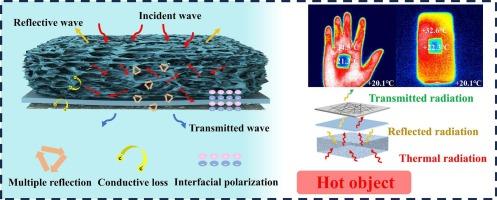环境干燥纤维素纸基夹层结构复合材料,具有宽带、低反射和高电磁干扰屏蔽效率
IF 12.5
1区 化学
Q1 CHEMISTRY, APPLIED
引用次数: 0
摘要
大多数报道的屏蔽材料都表现出以反射为主的屏蔽机制,这进一步导致了二次电磁辐射污染。这项工作报道了一种低反射和可扩展的纤维素纸基EMI屏蔽复合材料(ACMA),该复合材料具有三明治结构,通过在电导率梯度中组装含有MXene的气凝胶层,MXene涂层纸(MP)层和高导电性AgNWs/CNF膜(AC)层。研究了各层、AC-MP双层和AC-MP-气凝胶三层的屏蔽性能和屏蔽机理。结果表明,AC膜能显著提高MP的EMI SE,但产生超高的R系数(0.92)。气凝胶层能有效降低R系数,R系数与气凝胶层的MXene含量和厚度有关。当气凝胶的MXene/BC为90%,厚度为2.6 mm时,ACMA在X波段的平均EMI SE为71.46 dB, R系数为0.1。展示了一种大尺寸ACMA,在2-18 GHz频段实现56.82 ~ 75.85 dB的平均EMI SE,在8-18 GHz频段实现吸收主导屏蔽机制。此外,当气凝胶层与物体接触时,ACMA还表现出优异的热伪装性能。本文章由计算机程序翻译,如有差异,请以英文原文为准。

Ambient dried cellulose paper- based sandwich structural composite with broadband, low reflective, and high EMI shielding efficiency
Most reported shielding materials exhibit reflection-dominated shielding mechanisms, which further leads to the secondary electromagnetic radiation contamination. This work reports a low reflective and scalable cellulose paper- based EMI shielding composite (ACMA) with a sandwich structure via assembling of the MXene containing aerogel layer, MXene coated paper (MP) layer, and highly conductive AgNWs/CNF film (AC) layer in a conductivity gradient. The shielding performances and mechanisms of each layer, AC-MP bi-layer, and AC-MP-aerogel tri-layer are investigated. Results show that the AC film could significantly increase the EMI SE of MP but produce super high R coefficient (0.92). The aerogel layer is effective in decreasing the R coefficient, which is correlated with its MXene content and thickness. The ACMA yields an average EMI SE of 71.46 dB and ultralow R coefficient of 0.1 in the X band when the aerogel has a MXene/BC of 90 % and a thickness of 2.6 mm. A large size ACMA is showcased, and it achieves an average EMI SE ranging from 56.82 dB to 75.85 dB in 2–18 GHz and an absorption- dominated shielding mechanism in 8–18 GHz. In addition, the ACMA also demonstrates excellent thermal camouflage property as the aerogel layer contacts the object.
求助全文
通过发布文献求助,成功后即可免费获取论文全文。
去求助
来源期刊

Carbohydrate Polymers
化学-高分子科学
CiteScore
22.40
自引率
8.00%
发文量
1286
审稿时长
47 days
期刊介绍:
Carbohydrate Polymers stands as a prominent journal in the glycoscience field, dedicated to exploring and harnessing the potential of polysaccharides with applications spanning bioenergy, bioplastics, biomaterials, biorefining, chemistry, drug delivery, food, health, nanotechnology, packaging, paper, pharmaceuticals, medicine, oil recovery, textiles, tissue engineering, wood, and various aspects of glycoscience.
The journal emphasizes the central role of well-characterized carbohydrate polymers, highlighting their significance as the primary focus rather than a peripheral topic. Each paper must prominently feature at least one named carbohydrate polymer, evident in both citation and title, with a commitment to innovative research that advances scientific knowledge.
 求助内容:
求助内容: 应助结果提醒方式:
应助结果提醒方式:


